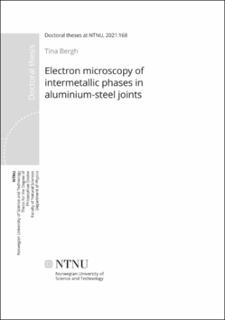| dc.contributor.advisor | Vullum, Per Erik | |
| dc.contributor.advisor | Holmestad, Randi | |
| dc.contributor.advisor | Westermann, Ida | |
| dc.contributor.author | Bergh, Tina | |
| dc.date.accessioned | 2021-05-20T12:38:45Z | |
| dc.date.available | 2021-05-20T12:38:45Z | |
| dc.date.issued | 2021 | |
| dc.identifier.isbn | 978-82-326-5276-1 | |
| dc.identifier.issn | 2703-8084 | |
| dc.identifier.uri | https://hdl.handle.net/11250/2755902 | |
| dc.description.abstract | Joints that combine the light weight of aluminium (Al) alloys with the high strength of steels, can be beneficial in structural components. For instance, in automobiles, Al-steel joints can enable improvement of the strength-to-weight distribution and in turn contribute to reduce the energy consumption from transport. However, Al-steel welding poses several challenges. One of the main challenges is formation and growth of hard and brittle intermetallic phases along the bonded interface, which are typically detrimental to the properties of the joint.
The overall goal of this work was to characterise the interface microstructure in selected Al-steel joints, and in turn to contribute to better understanding of the underlying bonding mechanisms and the performance of the joints. The intermetallic phases were also studied in a more fundamental sense to gain insight into the influence of alloying elements. The joints studied were produced by the solid state welding methods roll bonding and hybrid metal extrusion & bonding, and by the fusion welding method cold metal transfer. The main focus was placed on the interfacial intermetallic phase layers, which typically have thicknesses on the nanometre or micrometre scale in sound joints. Electron microscopy provides the spatial resolution to study such layers. The main tool was transmission electron microscopy, which enables acquisition of a broad range of complementary signals that can be used to characterise the specimen both in terms of morphology, chemical composition, and crystal structure, with a spatial resolution down to atomic scale.
The joints studied were made using Al alloys containing Si and Mn, amongst other elements, and the interfacial IMP layers in these joints had in common that they contained the αc-Al-(Fe,Mn)-Si phase. With prolonged interdiffusion, the θ-Fe4Al13 and η-Fe2Al5 phases also formed. Moreover, the alloying elements Si, Mn, Cr and Ni together led to a reduction in the growth rate of the total IMP layer. When it comes to the welding methods, the hybrid metal extrusion & bonding method showed great prospects for multi-metal welding, primarily due to its flexibility and the low process temperature. In joints made with this method, the underlying bonding mechanism was found to be a combination of microscale mechanical interlocking and formation of a nanoscale Al-Fe-Si layer. In one of the studied joints, the interfacial layer was only a few tens of nanometres thick and therefore posed extra challenges for characterisation. For this joint, scanning electron diffraction was used, which yields four dimensional datasets that, combined with data analysis, enables the local crystallography to be assessed. However, overlap of crystals is a recurring challenge with analysis of such data. Two methods to segment the signals associated with individual crystals were explored, and it was found that both could be used if artefacts were considered carefully. Overall, scanning electron diffraction techniques offer possibilities to characterise a wide range of materials, especially with the advent of direct electron detectors, and these opportunities should be seized in future studies. | en_US |
| dc.language.iso | eng | en_US |
| dc.publisher | NTNU | en_US |
| dc.relation.ispartofseries | Doctoral theses at NTNU;2021:168 | |
| dc.relation.haspart | Paper 1: T. Bergh, D.N. Johnstone, P. Crout, S. Høgås, P.A.Midgley, R. Holmestad, P.E. Vullum, A.T.J. van Helvoort. Nanocrystal segmentation in scanning precession electron diffraction data. Journal of Microscopy (2020) 279 158-167. | en_US |
| dc.relation.haspart | Paper 2: T. Bergh, L. Sandnes, D.N. Johnstone, Ø. Grong, F. Berto, R. Holmestad, P.A.Midgley, P.E. Vullum. Microstructural and mechanical characterisation of a second generation hybrid metal extrusion & bonding aluminium-steel butt joint. Materials Characterization (2021) 174 110761. | en_US |
| dc.relation.haspart | Paper 3: T. Bergh, H. Fyhn, L. Sandnes, J. Blindheim, Ø. Grong, R. Holmestad, F. Berto, P.E. Vullum. Microstructure and tensile properties of a multi-material aluminium-coppersteel-titanium butt joint made in one pass by hybrid metal extrusion & bonding. This article is not yet published and is therefore not included. | en_US |
| dc.relation.haspart | Paper 4: T. Bergh, S.M. Arbo, A.B.Hagen, J. Friis, J. Blindheim, I. Ringdalen, M.Z. Khalid, R.Holmestad, I.Westermann, P.E. Vullum. On intermetallic phases formed during interdiffusion between aluminium alloys and stainless steel. This article is not yet published and is therefore not included. | en_US |
| dc.relation.haspart | Paper 5: T. Bergh, H.W. Ånes, R. Aune, S.Wenner, R. Holmestad, X. Ren, P.E. Vullum. On interfacial intermetallic phase layers in cold metal transfer aluminium-steel joints made with an Al-Si-Mn alloy as filler material. This article is not yet published and is therefore not included. | en_US |
| dc.title | Electron microscopy of intermetallic phases in aluminium-steel joints | en_US |
| dc.type | Doctoral thesis | en_US |
| dc.subject.nsi | VDP::Matematikk og Naturvitenskap: 400::Fysikk: 430 | en_US |

